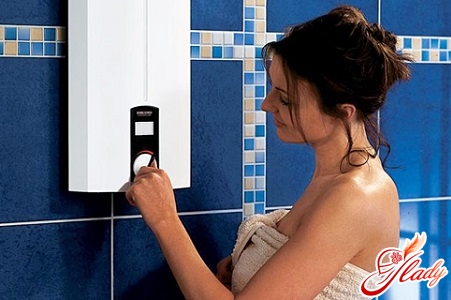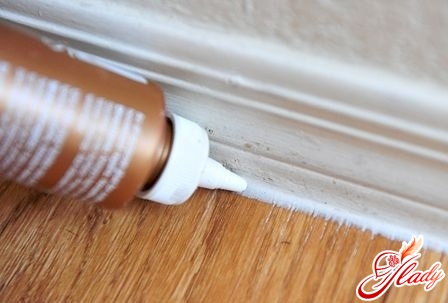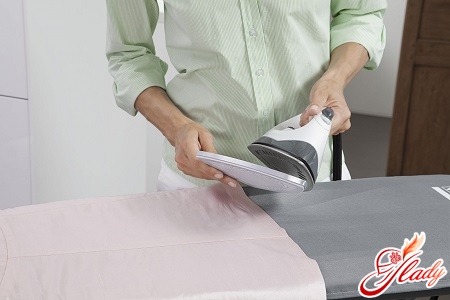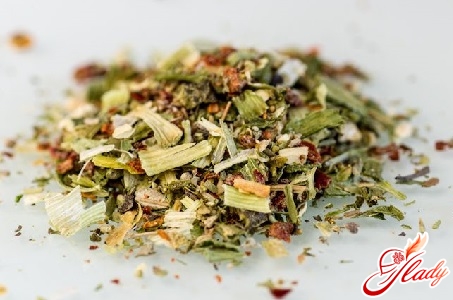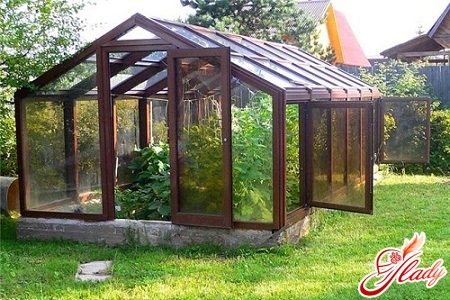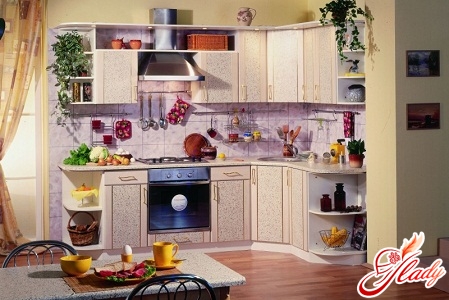 "He pulls, pulls, can not pull." I really do not want this to be a suitable characteristic for the kitchen hood, which is designed not only to decorate the interior (as some believe), but also to fulfill its direct purpose - to clean the air in the kitchen. How to choose a hood in the kitchen? On which model to stay? What to guide when choosing? Let's try to figure it out.
"He pulls, pulls, can not pull." I really do not want this to be a suitable characteristic for the kitchen hood, which is designed not only to decorate the interior (as some believe), but also to fulfill its direct purpose - to clean the air in the kitchen. How to choose a hood in the kitchen? On which model to stay? What to guide when choosing? Let's try to figure it out.
Range of hoods
All kitchen hoods can be divided into severalspecies depending on their shape and type of installation. Flat hoods (suspended) are attached to the wall directly above the plate. Such extracts are a separate structure without venting. The suspension hood module consists of a casing, a fan and a filter. Advantages of these models of hoods - low price, stylish appearance, easy installation. Disadvantages (well, as without them!) Suspension hoods - high noise level, low suction power, the need for frequent replacement of grease filters. Built-in hoods are mounted above the stove in a special hanging cabinet that hides the outflow pipe. The built in hood can be completely placed in the "camouflage" cabinet, but can also have a sliding panel. However, the visible hood becomes only during operation. This type of hoods is considered to be of better quality than hanging models, but the price of built-in hoods is much higher. However, in the event that the ventilation hole in the kitchen is too far from the plate, recessed hoods will solve this problem. Dome (fireplace) hoods. This, perhaps, is the most modern type of kitchen hood models. They perfectly fit into the interior of any kitchen, they have a fashionable and even ergonomic design and do not need replacing filters. These models of kitchen hoods can be completely metal, and can have different inserts and finishes of glass and wood. By the method of installation, they can be wall or island (mounted to the ceiling). Models of domed hoods differ not only in size, shape and color. They also have different technical characteristics. Despite the fact that this type of hoods is the most expensive, it is at the same time and the most common. Most likely, this is due to the excellent quality of these models, and high power, and the possibility of remote control. However, giving preference to a particular model, it is necessary to take into account not only the features of its appearance and compliance with the general style of the kitchen, but also technical parameters: power, quietness, durability,
Capacity and productivity of extracts
The capacity of the cooker hood is the amountair, which it is able to clean for an hour of work. Naturally, the higher the power of the hood, the higher its productivity. However, very powerful hoods do not have to be placed, for example, in a small kitchen. How to calculate the required power for rooms of different sizes? This can be known by multiplying the volume of the kitchen by ten (to find the volume, multiply the area of the room by the height of the streams). So, for example, for an average kitchen (an area of 8 square meters) of an ordinary city apartment (ceiling height 2 m 70 cm) exhaust hood with a capacity of 216 m3 / h is quite suitable. We obtained this power multiplying by 8 by 2.7 and by 10. However, the number obtained as a result of such calculations is the minimum index. Ideally, the productivity of the cooker hood should not be less than 600 m3 / h.
Noise level of hoods
The higher the productivity of the hood, the more powerfulher motor, and the louder the exhaust itself works. However, for comfortable work in the kitchen, unnecessary noise (especially loud) is completely undesirable. Therefore, you need to choose a hood that does not distract the hostess with its noise. However, modern models of kitchen hoods (even quite powerful ones) are equipped with anti-vibration pads and noise-absorbing units that solve the problem of excessive noise during exhaust operation. Nevertheless, choosing the model you like, check it and the volume of the sound in the operating mode.
Hood filters
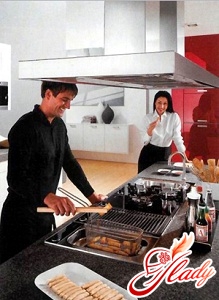 Types of filters in the kitchen hooddegrees affect the service life and the quality of its work. If the filter is qualitative, then it is able to neutralize almost all unpleasant (and pleasant too!) Smells, and along with them soot, fumes and fat suspensions in just five minutes. To choose a kitchen hood with a quality filter, you need to know that they can have only two types of filters - coarse filters and fine filters. Filters are also called fat (grease) filters. They are designed to catch and hold even the smallest particles of fat that get into the air during cooking. Moreover, the filter in the kitchen hood not only cleans the air, but also protects the engine and internal walls of the air cleaner, which extends the life of the hood to a considerable extent. Fat filters can be made of metal, acrylic and non-woven. Metal filters are reusable. For good work, it is enough to wash them at least once a month. Fat filters from nonwoven and acrylic - disposable. That is, after the filter is clogged with dirt and grease, it is simply thrown away, replacing it with a new and clean filter. Fine filters are called coal filters, because they use activated carbon. The main purpose of fine filters is to catch and neutralize (adsorb) odors. These filters are replaceable and the frequency of their replacement depends only on the intensity of use of the kitchen hood.
Types of filters in the kitchen hooddegrees affect the service life and the quality of its work. If the filter is qualitative, then it is able to neutralize almost all unpleasant (and pleasant too!) Smells, and along with them soot, fumes and fat suspensions in just five minutes. To choose a kitchen hood with a quality filter, you need to know that they can have only two types of filters - coarse filters and fine filters. Filters are also called fat (grease) filters. They are designed to catch and hold even the smallest particles of fat that get into the air during cooking. Moreover, the filter in the kitchen hood not only cleans the air, but also protects the engine and internal walls of the air cleaner, which extends the life of the hood to a considerable extent. Fat filters can be made of metal, acrylic and non-woven. Metal filters are reusable. For good work, it is enough to wash them at least once a month. Fat filters from nonwoven and acrylic - disposable. That is, after the filter is clogged with dirt and grease, it is simply thrown away, replacing it with a new and clean filter. Fine filters are called coal filters, because they use activated carbon. The main purpose of fine filters is to catch and neutralize (adsorb) odors. These filters are replaceable and the frequency of their replacement depends only on the intensity of use of the kitchen hood.
Modes of operation and ways of control
Modern kitchen hoods are able to work inone of the two modes - air exhaust and recirculation mode. There are also models that combine both versions of the hood. These modes differ significantly in the principle of operation. When the cooker hood works in a retraction mode, it takes the air from the room and takes it out through the ventilation. Filters installed in such models, first of all, protect the internal mechanism of drawing from grease and dirt, but do not purify the air. The recirculation system takes air, purifies it with filters and releases it again into the room. It is in the hoods with the recirculation system that grease filters and additional filters are used, which purify the air from grease, fumes, soot and dust. However, most modern models of hoods are able to work in any of these modes, and therefore suitable for any kitchen. Therefore, the question of how to properly choose the hood in the kitchen, depending on the method of air purification, is no longer so relevant. For many housewives an important factor of choice is the way to control the hood (turned on and off). This is understandable, since any hood (even the most complex model) should be managed easily. The most common types of control hood work:
- electronic - a light board or light-emitting diode indicators;
- push-button - pseudo-sensors that activate or deactivate various functions of the hood;
- slider - mechanical slide switch located in the base of the hood.
The principal difference in all these methodsthere is no control, so there is no need to talk about any advantages or disadvantages. Focus on your own habits and ideas about convenience.
Additional functions
In addition to its main function - air purification- Kitchen hoods are often equipped with additional functions. For example, lighting. Since the extractor is located directly above the plate, it is very convenient to have on it the source of illumination of the working space. Lighting is available on almost all modern models of hoods. The only difference is the type and power of the backlight:
- Halogen lamps (power 20 W);
- fluorescent lamps (power 9 W);
- compact incandescent lamps (power 20-40 W).
Halogen lamps have one undeniableadvantage - the most accurate color reproduction in artificial lighting. And since the color of food and preparing dishes is important for any cook, it is possible that this type of lighting is most suitable for kitchen hoods. If this does not play a special role for you, then pay attention to the location of the fixtures, the angle and the area of illumination. All the same, the light above the stove makes the cooking process not only better, but also much more pleasant. To incline you to the choice of a particular model can be the fact of equipping the hood with glass or trellised shelves for storing kitchen utensils. But even if the model does not have such additions, ask about the option of additional equipment. By the way, this possibility is provided by many manufacturers of kitchen hoods, and this necessary subject of household appliances can be completed or, conversely, deconstructed in accordance with your wishes. And after you choose a kitchen hood you can still, you will only have to enjoy a successful choice and enjoy the clean air of your kitchen. We advise you to read:




